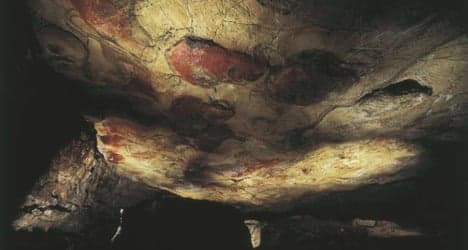Spain to keep prehistoric Altamira cave open

The Spanish government has assured Unesco that the reintroduction of controlled visits hasn't damaged the famous rock paintings at the country's important Altamira cave site.
Spain’s Culture Ministry has decided that the experiment in permitting small groups of visitors to see the rock paintings at the Altamira site has been successful with the cave environment not degraded as a result and the prehistoric art in no danger.
Spanish newspaper El País has reported that ministry officials met with representatives of Unesco in Paris and presented plans for the future management of the World Heritage site, which included the continuation of controlled visits.
In February of this year the first group of visitors were allowed to access the cave, which had been closed to the public for 12 years. Over six months up to August five people a week, selected by the drawing of lots in the Altamira museum, were allowed to enter the cave for less than ten minutes.
The presentation that Spain’s Culture Ministry made to Unesco included the results of an analysis of this experiment, which suggested that the effect of visits had not had a detrimental impact on the site.
The cave located at Santillana del Mar, in the Cantabria region, was closed in 2002 after damages had been reported to its polychrome prehistoric paintings from the carbon dioxide in the breath of the large number of visitors.
Fewer debates are fiercer in the scientific community than whether the proximity of human beings can cause irreparable damage to prehistoric cave paintings. People’s breath inside a closed cave environment will change the level of humidity in the air and introduce microorganisms which could contribute to an ecosystem which ends up damaging the ancient pigments.
The case of France’s Lascaux cave is often cited. There the cave paintings are suffering the ravages of mould and lichen, with the fact that visitors were once allowed in often cited as one of the causes.
According to Alfonso Muñoz, the deputy director of Spain’s IPC artistic heritage agency, the new report on Altamira allows for a precise "diagnosis on the situation inside the cave". "We now have far better knowledge of the processes which tale place inside the cave," Muñoz told El País.
This means that the situation will be monitored closely and action could be taken to change the scheduling of visits if any dangers were to be detected. "Even keeping the cave closed does not guarantee its conservation," Muñoz added.
The Altamira cave, whose walls are covered with paintings that include abstract shapes and animal subjects over a length of more than 270 metres (885 feet), was discovered in 1868.
It was inhabited approximately 35,000 to 13,000 years ago.
Comments
See Also
Spain’s Culture Ministry has decided that the experiment in permitting small groups of visitors to see the rock paintings at the Altamira site has been successful with the cave environment not degraded as a result and the prehistoric art in no danger.
Spanish newspaper El País has reported that ministry officials met with representatives of Unesco in Paris and presented plans for the future management of the World Heritage site, which included the continuation of controlled visits.
In February of this year the first group of visitors were allowed to access the cave, which had been closed to the public for 12 years. Over six months up to August five people a week, selected by the drawing of lots in the Altamira museum, were allowed to enter the cave for less than ten minutes.
The presentation that Spain’s Culture Ministry made to Unesco included the results of an analysis of this experiment, which suggested that the effect of visits had not had a detrimental impact on the site.
The cave located at Santillana del Mar, in the Cantabria region, was closed in 2002 after damages had been reported to its polychrome prehistoric paintings from the carbon dioxide in the breath of the large number of visitors.
Fewer debates are fiercer in the scientific community than whether the proximity of human beings can cause irreparable damage to prehistoric cave paintings. People’s breath inside a closed cave environment will change the level of humidity in the air and introduce microorganisms which could contribute to an ecosystem which ends up damaging the ancient pigments.
The case of France’s Lascaux cave is often cited. There the cave paintings are suffering the ravages of mould and lichen, with the fact that visitors were once allowed in often cited as one of the causes.
According to Alfonso Muñoz, the deputy director of Spain’s IPC artistic heritage agency, the new report on Altamira allows for a precise "diagnosis on the situation inside the cave". "We now have far better knowledge of the processes which tale place inside the cave," Muñoz told El País.
This means that the situation will be monitored closely and action could be taken to change the scheduling of visits if any dangers were to be detected. "Even keeping the cave closed does not guarantee its conservation," Muñoz added.
The Altamira cave, whose walls are covered with paintings that include abstract shapes and animal subjects over a length of more than 270 metres (885 feet), was discovered in 1868.
It was inhabited approximately 35,000 to 13,000 years ago.
Join the conversation in our comments section below. Share your own views and experience and if you have a question or suggestion for our journalists then email us at [email protected].
Please keep comments civil, constructive and on topic – and make sure to read our terms of use before getting involved.
Please log in here to leave a comment.